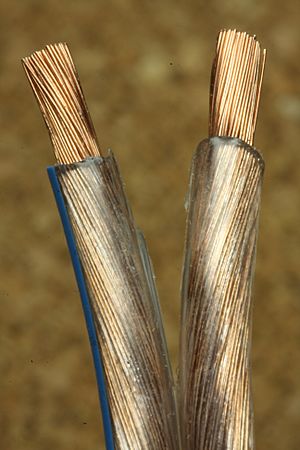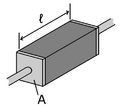Electrical conductor facts for kids
A conductor is a special material that lets things like electricity, heat, or sound travel through it easily. Think of it like a pathway for energy! When we talk about electrical conductors, we mean materials that are really good at letting electric current flow.
Most metals, like iron and copper, are excellent electrical conductors. This is why they are often used to make wires that carry electric current to our homes and devices. Even plasma, which is a super hot, charged gas, can conduct electricity very well.
Contents
What Makes a Material a Conductor?
A material is a conductor if it has tiny particles, like electrons, that can move freely. These free-moving particles are what carry the electric charge or heat through the material. In metals, these are often electrons that are not tightly bound to individual atoms.
Electrical Conductors: Powering Our World
Electrical conductors are essential for our modern world. Without them, electricity couldn't travel from power plants to our homes.
- Metals: Many metals are great at conducting electricity. Copper is a popular choice for wires because it conducts electricity very well and is also quite flexible. Aluminum is another common conductor, especially for overhead power lines.
- Water: Pure water is not a good conductor, but impure water (like tap water or water with salt in it) can conduct electricity. This is because it contains dissolved minerals and salts that create free-moving charged particles.
- Living Tissues: Our bodies, and other living tissues, are mostly water and contain salts. This makes them good conductors of electricity. This is why it's important to be careful around electricity!
Materials That Don't Conduct Well
Not all materials are good conductors. Some make it hard for electricity to flow, while others stop it completely.
- Semiconductors: These materials are somewhere in between conductors and insulators. They can conduct electricity, but not as easily as metals. Their ability to conduct can be controlled, which makes them very useful in electronic devices like computers and smartphones. Common semiconductors include silicon and germanium.
- Resistors: These materials are designed to resist the flow of electricity. They are used in electronic circuits to control how much current flows.
- Insulators: An insulator is a material that stops electric current from flowing. Materials like plastic, rubber, and glass are good insulators. This is why electrical wires are often covered with plastic – it keeps the electricity safely inside the wire and prevents shocks.
Superconductors: The Ultimate Conductors
Imagine a material where electricity could flow forever without losing any energy! That's what a superconductor does. When some materials are cooled to extremely low temperatures, they become superconductors. This means they offer absolutely no resistance to the flow of electricity. Scientists are still researching how to use superconductors more widely, as they could revolutionize many technologies.
How Temperature Affects Conductors
The ability of a conductor to carry electricity can change with temperature. Generally, a conductor's resistance tends to get higher when its temperature also gets higher. This is because the particles inside the material vibrate more, making it harder for electrons to move freely.
Images for kids
See also
 In Spanish: Conductor eléctrico para niños
In Spanish: Conductor eléctrico para niños




